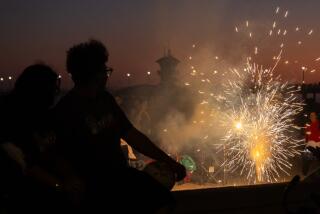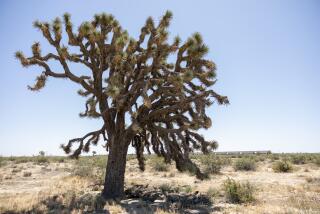Astronomers See the Light--And Really Hate It
PHOENIX â Drive through the Arizona desert on a clear night and the heavens open above you.
Orion, the Pleiades, the edge of the Milky Way and more fill the skyâs black canopy. It gives pause to hikers, sets a romantic backdrop for lovers and allows scientists to gaze into the far reaches of the universe.
Until you get near a city, that is, where artificial light from street lamps, spotlights and neon signs overwhelms the faint dots twinkling above.
Astronomers call it light pollution. They also call it a threat to the research and technology spinoffs that pump nearly $1 billion into Arizonaâs economy each year.
âWeâre losing a huge amount of the universe,â said Chris Corbally, a Tucson astronomer studying the spectrum of starlight to learn what stars are made of, what they burn and what surrounds them.
The spread of light pollution is a consequence of Arizonaâs rapid growth.
Maricopa County is one of the nationâs fastest-growing counties. The 4 million people who live in the greater Phoenix area use enough light to hide many stars and affect research at observatories as far away as Flagstaff, 116 miles to the north.
Even light from small towns can hurt, if the communities are close enough to a telescope.
âItâs compounded enormously when you go at it with a telescope because itâs so much more sensitive,â Corbally said. âWe can still do good stuff, but at some stage it will become alarming.â
This year, the concerns about the light pollution have reached the Legislature, where state lawmakers are considering two proposals that seek to limit or reduce the man-made glare.
A bill sponsored by state Sen. Darden Hamilton would require street lights to be shielded to reduce light pollution while still illuminating the ground.
Another sponsored by state Rep. Jeff Hatch-Miller would require any city or town with a population of more than 50,000 to adopt an ordinance regulating outdoor lighting by 2004 and to reduce light levels 10% by 2006.
Officials have reason to worry, because any negative effects on research could have repercussions for the economy.
Astronomy projects at Lowell Observatory and the U.S. Naval Observatory in Flagstaff; Kitt Peak southwest of Tucson; Mt. Hopkins north of Nogales; and Mt. Graham near Safford employ about 1,000 scientists and support staff.
The latest addition is an $87-million binocular telescope that the University of Arizona is building on Mt. Graham. It is being built with twin 8.4-meter mirrors and will be the largest of its kind in the world.
Astronomy spinoffs in missile defense programs, optics and other technologies add thousands more high-paid workers and hundreds of millions of dollars to the stateâs economy.
These are high-paying jobs in clean industries and they are here because Arizona is one of the few places in the country with dark skies.
A study released last fall by scientists from the National Oceanic and Atmospheric Administration and the Universita di Padova in Italy found that about two-thirds of the global population lives under skies marred by a flood of artificial light.
The glow is so bright and covers so much ground that one in five people worldwide cannot see the bright band of the Milky Way, according to the study.
âI was an astronomy student at U of A 30 years ago when we talked about light pollution,â state Sen. Ruth Solomon said. âWe called it lack of seeing ability, and itâs gotten much worse. If you just look at the night sky with the naked eye, you canât even pick out the Pleiades anymore.â
Solomon said Tucsonâs emergence as a leading optics center is due to the presence of Kitt Peak and the universityâs pioneering work in astronomy, mirror-casting and related technologies. But if Arizona does not protect its dark skies from light pollution, astronomers and the associated industries will go elsewhere, such as Hawaii, Chile or beyond, she said.
Hatch-Miller said bright city lights also damage the desertâs appeal to tourists and waste energy.
âThe concept of having a dark sky is part of our natural endowment. It was part of what you got when you went into the desert,â Hatch-Miller said. âWeâve been losing that.â
âAbout 50% of the glow we see in the night is wasted energy,â Hatch-Miller said. âIt doesnât do anything for safety, driving or keeping offices open. Itâs just wasted. If we use less energy because we use it more wisely, thatâs just to our advantage.â
Reducing light pollution does not have to be onerous or expensive, Corbally said.
Shielding lamps and changing outdoor lights from mercury vapor bulbs to sodium-based lighting are simple steps that can help preserve Arizonaâs dark night skies, he said.
âItâs not something that people think about,â Corbally said. âOnce they think about it, itâs something they say, âOh yeah, of course.â â
âThis is a resource,â he said. âWeâve got it. Letâs not be so dumb as to throw it away.â






